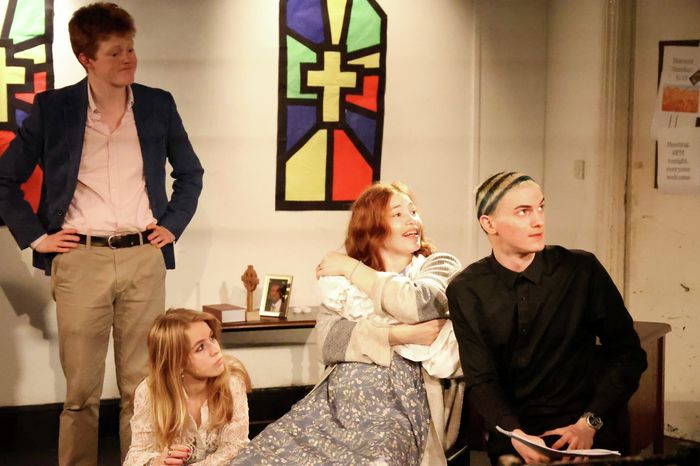Murder on the Orient Express: for those who like their Christie camp
Showing at the Arts Theatre, this crime classic delivers on the comedy – but where’s the intrigue?

The opening of Murder on the Orient Express is disconcerting. Projections trace the murder of little Daisy Armstrong (key to the plot) as the cast of suspects throb back and forth in one unified motion – very physical theatre-y, sure, but what did it accomplish? That’s something even Poirot might be stumped by.
This production’s greatest asset is undoubtedly its staging: ambitious, creative and highly effective. Following from the opening, the scene in the hotel restaurant is upbeat and energetic. An expertly-utilised revolve means that the characters gain and concede focus as they move towards and away from the stage front. This had the potential to be very ‘in-your-face’, but was carried out in a smooth, understated fashion.
“The audience were incredibly receptive, laughing away at the jokes”
The turntable becomes even more important when the vast Orient Express is unveiled – carriages rotate around the stage, revealing the corridor, cabins, and windows in one fell, polished swoop. The sheer magnitude of the carriage, stretched across the length of the stage, is impressive, but beyond this, it allowed the audience to feel as if they were peering through the windows, watching the characters, intensifying the air of mystery and unease. The chugging train is emphasised by a projection screen which lives above, sometimes portraying the movement of the tracks, sometimes projecting an ominous silhouette of Poirot’s head, occasionally setting up the snowy exterior that seems to suffocate the characters as the story takes a turn for the menacing.
Ken Ludwig’s script is economical – we lose six main characters in the jump from page to stage (a cardinal sin to anyone who knows the importance of there being at least twelve suspects in the book). And unlike the titular express, moored in a snowdrift, the story chugs along at full-throttle speed. The body is found, the investigation opened and the killers (not a spoiler – the book is 90 years old) uncovered at a quick, uninterrupted pace. The whole affair tidies itself up in about two hours – what was the hurry? The story, like its characters, seemed to be in a rush. But the reason we still consume Christie a lifetime on is for the lush set and costumes, the sizzling intrigue. We could’ve spent more time on these passengers, wonderfully dressed up with nowhere to go, if it meant a slower burn and better-developed mystery. The stranded train wasn’t heading anywhere fast. Why was the show?
The pace inhibits our investment in characters. To aid the runtime, the culprits become a lot clumsier than in the novel, and the moral quandary posed by the plot twist (trying really hard not to spoil here) emerges as an afterthought, establishing itself in a few lines of dialogue and resolving itself in less. So much for Poirot (Michael Maloney) telling us it’s among the toughest cases of his career Maloney does a fine job of the Belgian accent and twirling moustache, even if he is a little shouty at the end. The ensemble, meanwhile, do a swell job of filling out Christie’s colourful characters – they’re just hampered slightly by the script.
“The stranded train wasn’t heading anywhere fast. Why was the show?”
Which is our central nit-pick: the show goes for too many laughs. Granted, Christie has developed a certain campness with age, but here it’s stretched to such a degree that certain moments belong in a pantomime. Mrs Hubbard (Christine Kavanaugh), one of Christie’s overbearing Americans, is now a feisty cougar trading low-level barbs with Debbie Chazen’s Russian princess. Both actors are phenomenal, but the comedic remodelling takes the place of more interesting character study – and opens up a few plot holes when you consider the twist reveal more deeply. This lighter tone was appreciated in the build-up, when characters were being established, but it juxtaposed with the eerie music and dark lighting throughout the latter half, and made the segue into the climactic moments a little too jarring. In an already-tight script, the something’s gotta give, and this time it’s our investment in the intrigue of the story. That said, the ‘chummy’ dynamic between Poirot and Bouc worked perfectly, and whilst slightly slapstick, it provided us with gems of moments, such as when Poirot crawled underneath Bouc’s legs when investigating the scene of the murder.
What we would like to highlight is that the production was overall a very entertaining watch, and credit must be given for that. The audience were incredibly receptive, laughing away at the jokes, listening intently as direct addresses were made. Though this isn’t a statement we expected to be making about a narrative surrounding issues of moral versus legal justice, we can definitely say that we had fun.
The show is a spectacle – it bizarrely combines melodrama, physical theatre, complex staging and tech, and manages to bring to life this iconic murder mystery. Perhaps if it weren’t for the rich history of the story – with its many adaptations for film and TV – we would have been less inclined to notice its shortcomings. Yet, the great performances and spectacular staging went a long way to making up for the feeling of wanting just a little bit more. At the end of the day, 90 years on, this Christie classic still sells, and it sells in style.
‘Murder on the Orient Express’ is showing at the Cambridge Arts Theatre from Tuesday 29th October to Saturday 2nd November, at 7:30pm.
 Features / Should I stay or should I go? Cambridge students and alumni reflect on how their memories stay with them15 December 2025
Features / Should I stay or should I go? Cambridge students and alumni reflect on how their memories stay with them15 December 2025 News / Cambridge study finds students learn better with notes than AI13 December 2025
News / Cambridge study finds students learn better with notes than AI13 December 2025 News / Dons warn PM about Vet School closure16 December 2025
News / Dons warn PM about Vet School closure16 December 2025 News / News In Brief: Michaelmas marriages, monogamous mammals, and messaging manipulation15 December 2025
News / News In Brief: Michaelmas marriages, monogamous mammals, and messaging manipulation15 December 2025 Comment / The magic of an eight-week term15 December 2025
Comment / The magic of an eight-week term15 December 2025









